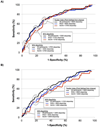Daily walking and the risk of incident functional limitation in knee osteoarthritis: an observational study
- PMID: 24923633
- PMCID: PMC4146701
- DOI: 10.1002/acr.22362
Daily walking and the risk of incident functional limitation in knee osteoarthritis: an observational study
Abstract
Objective: Physical activity is recommended to mitigate functional limitations associated with knee osteoarthritis (OA). However, it is unclear whether walking on its own protects against the development of functional limitation.
Methods: Walking over 7 days was objectively measured as steps/day within a cohort of people with or at risk of knee OA from the Multicenter Osteoarthritis Study. Incident functional limitation over 2 years was defined by performance-based (gait speed <1.0 meter/second) and self-report (Western Ontario and McMaster Universities Osteoarthritis Index physical function score >28 of 68) measures. We evaluated the association of steps/day at baseline with developing functional limitation 2 years later by calculating risk ratios adjusted for potential confounders. The number of steps/day that best distinguished risk for developing functional limitation was estimated from the maximum distance from chance on receiver operating characteristic curves.
Results: Among 1,788 participants (mean age 67 years, mean body mass index 31 kg/m(2) , 60% women), each additional 1,000 steps/day was associated with a 16% and 18% reduction in incident functional limitation by performance-based and self-report measures, respectively. Walking <6,000 and <5,900 steps/day were the best thresholds to distinguish incident functional limitation by performance-based (sensitivity 67.3%, specificity 71.8%) and self-report (sensitivity 58.7%, specificity 68.9%) measures, respectively.
Conclusion: More walking was associated with less risk of functional limitation over 2 years. Walking >6,000 steps/day provides a preliminary estimate of the level of walking activity to protect against developing functional limitation in people with or at risk of knee OA.
Copyright © 2014 by the American College of Rheumatology.
Figures

Comment in
-
Gehen als Therapieform bei Kniearthrose?Praxis (Bern 1994). 2015 Feb 11;104(4):207-8. doi: 10.1024/1661-8157/a001923. Praxis (Bern 1994). 2015. PMID: 25669227 German. No abstract available.
References
-
- Murray CJ, Richards MA, Newton JN, Fenton KA, Anderson HR, Atkinson C, et al. UK health performance: findings of the Global Burden of Disease Study 2010. Lancet. 2013;381(9871):997–1020. - PubMed
-
- McAlindon TE, Bannuru RR, Sullivan MC, Arden NK, Berenbaum F, Bierma-Zeinstra SM, et al. OARSI Guidelines for the Non-Surgical Management of Knee Osteoarthritis. Osteoarthritis and Cartilage. 2014;(0) - PubMed
-
- Focht BC. Effectiveness of exercise interventions in reducing pain symptoms among older adults with knee osteoarthritis: a review. J Aging Phys Act. 2006;14(2):212–235. - PubMed
Publication types
MeSH terms
Grants and funding
- AG-18947/AG/NIA NIH HHS/United States
- R01AR062506/AR/NIAMS NIH HHS/United States
- P30 AG031679/AG/NIA NIH HHS/United States
- T32 AR007598/AR/NIAMS NIH HHS/United States
- R01 AR062506/AR/NIAMS NIH HHS/United States
- U01 AG018947/AG/NIA NIH HHS/United States
- P60 AR047785/AR/NIAMS NIH HHS/United States
- AG-18820/AG/NIA NIH HHS/United States
- R24HD0065688/HD/NICHD NIH HHS/United States
- R24 HD065688/HD/NICHD NIH HHS/United States
- AR-007598/AR/NIAMS NIH HHS/United States
- AR-47785/AR/NIAMS NIH HHS/United States
- U01 AG019069/AG/NIA NIH HHS/United States
- U01 AG018820/AG/NIA NIH HHS/United States
- AG-18832/AG/NIA NIH HHS/United States
- U01 AG018832/AG/NIA NIH HHS/United States
- AG-19069/AG/NIA NIH HHS/United States
- 1P30AG031679/AG/NIA NIH HHS/United States
LinkOut - more resources
Full Text Sources
Other Literature Sources
Medical

